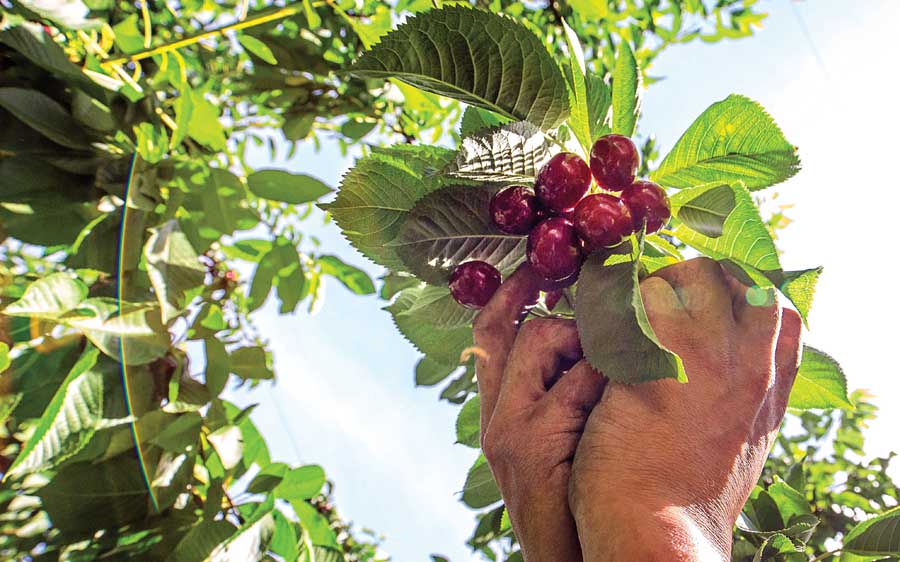
Gonzalo Villareal harvests Sweetheart cherries in Selah, Washington on July 16, 2015. (TJ Mullinax/Good Fruit Grower file photo)
Sweetheart cherries are growing in market share in Washington, surpassing Bings for the first time in 2016.
That’s perhaps because growers have caught on to the benefits of the high yield cherry, which offers a faster return on investment than Bing, according to a recent analysis by Washington State University economists.
Overall, the cost of production analysis shows an expected profit of $1.3 million for Sweethearts, compared to $958,580 for Bings, over the 25-year life of a model orchard.
This analysis can benefit growers looking for a starting point when considering the return on investment in a new planting and serve as an industry standard to support a loan application or loss claim, said Karina Gallardo, WSU economist and an author of the analysis updated last year.
Of course, every orchard is different. For the analysis, Gallardo used a “typical orchard” — with a 10-acre block of 272 trees per acre grown with a central leader architecture — as part of a diversified 300-acre farm with apples, cherries and pears.
A focus group of growers helped shape that typical orchard and the costs associated with planting and managing it.
For the “typical orchard,” which does not include any trellis, establishment costs for both Bing and Sweetheart blocks are just over $20,000 per acre, with Sweetheart trees costing slightly more upfront.
Both blocks are assumed to reach full production in the sixth year. For Sweethearts, the total production costs from that year on are estimated at $27,514 and for Bing at $21,886.
The higher production cost is largely driven by the increased need for harvest labor, due to Sweetheart’s higher yield.
The analysis puts Sweetheart full production at about 24,000 pounds per acre and Bing production closer to 18,000 pounds. Considering an 80 percent packout at those production levels, Sweethearts then break even at $1.43 per pound and Bings at $1.52 per pound.
But when an orchard will break even also depends on how you calculate costs. Gallardo says many growers just use a cash flow analysis, but that fails to include additional costs, such as depreciation or the lost opportunity to invest the money elsewhere.
“Our studies include that extra layer of cost,” Gallardo said, but she breaks down the cost assumptions into categories so growers can match the analysis with their own cost calculations. “We don’t want to impose it on anyone. … We just want to provide the whole range of information.”
However, she recommends taking the more comprehensive cost assessment.
“If they use the four categories — the cash costs, the fixed costs, the depreciation and the opportunity cost — then they will be in a very healthy financial position and in a better position to respond to volatility in market prices or a change in horticultural practice or in a better position for investment in upgrading their orchard,” she said.
The analysis used 2015 prices of $2.05 per pound for Sweetheart and $2.10 for Bing and assumed interest payments on the initial investment at 5 percent, which Gallardo said is the average rate for farm loans from 2010 to 2015.
Considering all those factors, over the course of the orchard’s 25-year life, the expected profit is $1.3 million for Sweethearts and $958,580 for Bings, both considering a discount rate of 5 percent to account for the opportunity cost of the capital invested in the orchard. •
ONLINE
WSU’s enterprise budgets for sweet cherries and a variety of other crops can be found online at ses.wsu.edu/enterprise_budgets
Analyze your operation
Growers can tailor the analysis by entering their own prices, yield and costs for labor, chemicals, equipment and insurance in an Excel workbook found at Washington State University’s crop budget website. (ses.wsu.edu/enterprise_budgets)
WSU has simplified its analysis in recent years, WSU economist Karina Gallardo said. Instead of estimating the cost of each chemical, for example, it consolidates those costs.
“We found that level of detail is overwhelming for growers,” she said. “The more general, the impact on the bottom line, that’s what they want to see.”
– by Kate Prengaman






Leave A Comment